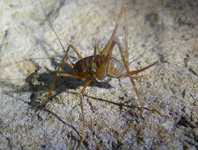Abstract
The genus Chinavia Orian has a great diversity of species, being distributed in the Nearctic, Neotropical and Afrotropical regions (Rolston 1983; Schwertner & Grazia 2007, Grazia & Schwertner 2017). The genus is included in the subfamily Pentatominae, tribe Nezarini, whose individuals retain their green coloration after death, average size between 9 and 19 mm, and considered polyphagous (Rolston 1983; Schwertner et al. 2002; Rider 2020). Some species of Chinavia are recorded as important crop pests in different countries (e.g. Matesco et al. 2007; Herbert & Toews 2012), and those species are better known regarding distribution, ecology and other biological aspects. However, the great majority of species is known only for the adult morphology, and there are still problems concerning the correct identification of the species due to their wide distribution.
References
De Almeida Rocha, D., De Almeida, M.R., De Sena Batista, J.A. & De Andrade, A.J. (2019) LutzoDexTM-A digital key for Brazilian sand flies (Diptera, Phlebotominae) within an Android App. Zootaxa, 4688 (3), 382–388.
https://doi.org/10.11646/zootaxa.4688.3.4
Cranston, P.S. (2019) Identification guide to genera of aquatic larval Chironomidae (Diptera) of Australia and New Zealand. Zootaxa, 4706 (1), 71–102.
https://doi.org/10.11646/zootaxa.4706.1.3
Dallas, W.S. (1851) List of the specimens of hemipterous insects in the collection of the British Museum. Part 1. Printed by order of the Trustees, London, 368 pp.
https://doi.org/10.5962/bhl.title.20373
Genevcius, B.C., Grazia, J. & Schwertner, C.F. (2012) Cladistic analysis and revision of the obstinata group, genus Chinavia Orian (Hemiptera: Pentatomidae). Zootaxa, 3434 (1), 1–30.
https://doi.org/10.11646/zootaxa.3434.1.1
Genevcius, B.C. & Schwertner, C.F. (2014) Review and phylogeny of the geniculata group, genus Chinavia (Heteroptera: Pentatomidae), with notes on biogeography and morphological evolution. Zootaxa, 3847, 33–56.
https://doi.org/10.11646/zootaxa.3847.1.2
Grazia, J. & Schwertner, C. (2017) Classification, Phylogeny, Biology and Reproductive Behavior. In: Čokl, A. & Borges, M. (Eds.), Stink Bugs. CRC Press, Boca Raton, pp. 1–30.
https://doi.org/10.1201/9781315120713-2
Herbert, J.J. & Toews, M.D. (2012) Seasonal Abundance and Population Structure of Chinavia hilaris and Nezara viridula (Hemiptera: Pentatomidae) in Georgia Farmscapes Containing Corn, Cotton, Peanut, and Soybean. Annals of the Entomological Society of America, 105, 582–591.
https://doi.org/10.1603/an12008
Matesco, V.C., Schwertner, C.F. & Grazia, J. (2007) Descrição dos estágios imaturos e biologia de Chinavia pengue (Rolston) (Hemiptera, Pentatomidae). Revista Brasileira de Entomologia, 51, 93–100.
https://doi.org/10.1590/S0085-56262007000100016
Rider, D.A. (2020) Pentatomoidea Home Page. Available from: https://www.ndsu.edu/pubweb/~rider/Pentatomoidea/Genus_Nezarini/Chinavia.htm (Accessed 15 June 2020)
Rolston, L.H. (1983) A Revision of the Genus Acrosternum Fieber, Subgenus Chinavia Orian, in the Western Hemisphere (Hemiptera: Pentatomidae). Journal of the New York Entomological Society, 91, 97–176.
Schneider, S.A., Fizdale, M.A. & Normark, B.B. (2019) An online interactive identification key to common pest species of aspidiotini (Hemiptera, Coccomorpha, Diaspididae), version 1.0. ZooKeys, 867, 87–96.
https://doi.org/10.3897/zookeys.867.34937
Schwertner, C.F., Albuquerque, G.S. & Grazia, J. (2002) Descrição dos estágios imaturos de Acrosternum (Chinavia) ubicum Rolston (Heteroptera: Pentatomidae) e efeito do alimento no tamanho e coloração das ninfas. Neotropical Entomology, 31, 571–579.
https://doi.org/10.1590/s1519-566x2002000400009
Schwertner, C.F. & Grazia, J. (2007) O gênero Chinavia Orian (Hemiptera, Pentatomidae, Pentatominae) no Brasil, com chave pictórica para os adultos. Revista Brasileira de Entomologia, 51, 416–435.
https://doi.org/10.1590/s0085-56262007000400005


